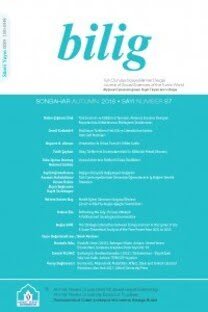Krokodil Dergisinde Türk Devlet Adamları ile İlgili Karikatürlerin Görsel Retorik Analizi: 1922-1924
SSCB, Krokodil dergisi, karikatür, Mustafa Kemal, Vahdeddin, Abdülmecid, görsel retorik analizi, USSR, Krokodil magazine, cartoon, Abdulmejid, visual rhetorical analysis
Visual Rhetorical Analysis of Cartoons about Turkish Statesmen in Magazine Krokodil: 1922-1924
USSR, Krokodil magazine, cartoon, Mustafa Kemal, Abdulmejid, visual rhetorical analysis,
___
- Alaniz, José. Komiks: Comic Art in Russia. University Press of Mississippi, 2011.
- Aydın, Ayşe. “Hıristiyan Dinindeki Martir-Aziz ve Rölik Kültünün Kılıkya-Isaurya Bölgesi Hıristiyanlığına Yansımaları.” Olba, no. 17, 2009, ss. 53-82.
- Barghoor, Frederic K C. Soviet Foreign Propaganda. New Jersey Princeton University Press, 1964.
- Barthes, Roland. Göstergebilimsel Serüven. Çev. Mehmet Rifat-Sema Rifat, Yapı Kredi, 1993.
- Bell, Philip MH. “Government Strategies on Influencing Public Opinion: Assessment, Censorship, Propaganda.” Mélanges de l’école française de Rome, vol. 108, no. 1, 1996, pp. 65-71.
- Brummett, Barry. Rhetorical Dimensions of Popular Culture. University of Alabama Press, 1991.
- Burke, Kenneth. Language as Symbolic Action: Essays on Life, Literature, and Method. University of California Press, 1966.
- Čeremnyh, Mihail Mihajlovič. “Zrja Podojnik Kupil.” Krokodil, vol. 21, no. 51, 1923.
- Demm, Eberhard (1993). “Propaganda and Caricature in the First World War.” Journal of Contemporary History, vol. 28, no. 1, 1993, pp. 163-192.
- Domenach, Jean Marie. Politika ve Propaganda. Çev. Tahsin Yücel, Varlık Yayınları, 1995.
- Domenach, Jean-Marie. “Leninist Propaganda.” Public Opinion Quarterly, vol. 15, no. 2, 1951, pp. 265-273.
- Efimov, Boris. Desjatʹ Desjatiletij: O Tom, Čto Videl. Perežil, Zapomnil. Vagrius, 2000.
- Efimov, Boris Efimova. “Papa i Syn.” Krokodil, vol. 9, no. 21, 1922.
- Ellison, Grace. An Englishwoman in Angora. Cambridge University Press, 2014.
- Etty, John. Graphic Satire in the Soviet Union: Krokodil’s Political Cartoon. University Press of Mississippi, 2018.
- Ganf, Julij Abramovič. “Čʹja Agitacija Zažigatelʹnej.” Krokodil, vol. 12, no. 122, 1925.
- Gračëv, Sergej. Satiričeskij «Krokodil»: Šutki, Kotorye Aktualʹny i Segodnja Argumenty i Fakty. Argumenty i Fakty, 17 Aralık 2020, https://aif.ru/culture/book/satiricheskiy_krokodil_shutki_kotorye_aktualny_i_segodnya.
- Ilʹičev, Ryklin Malenkov. Postanovlenie Orgbjuro CK VKP(b) o Žurnale “Krokodil.” Stalinism, 15 Aralık 2020, http://stalinism.ru/kultura-iiskusstvo/postanovlenie-orgbyuro-tsk-vkp-b-o-zhurnale-krokodil.html.
- Kijanskaja, Oksana Ivanovna, i David Markovič Felʹdman. “K istorii sovetskoj satiričeskoj pečati 1930-h godov: žurnal «Krokodil».” Vestnik RGGU. Serija: Literaturovedenie. Jazykoznanie. Kulʹturologija, vol. 12, no. 134, 2014, pp. 71-85.
- Lasswell, Harold D. “The Theory of Political Propaganda.” American Political Science Review, vol. 21, no. 3, 1927, pp. 627-631.
- Lenin, Vladimir Ilʹič. “O Prave Nacij Na Samoopredelenie.” O Gosudarstve i Prave 1, 1914.
- Lynch, Bohun. А History of Caricature. Faber & Gwyer, 1926.
- Maljutin, Ivan Andreevič. “Nevolʹnyj Paločnik.” Krokodil, vol. 18, no. 30, 1922.
- Maljutin, Ivan Andreevič. “Nacionalʹnoe Samoopredelenie.” Krokodil, vol. 8, no. 38, 1923.
- McKenna, Kevin J. All the Views Fit to Print: Changing Images of the U.S. in Pravda Political Cartoons, 1917–1991. Peter Lang, 2001.
- Melʹnikov, Dmitrij Ivanovič. ____________, Krokodil, vol. 15, no. 27, 1922.
- Meyer, Michel. Retorik. Çev. İsmail Yerguz, Dost Kitabevi Yayınları, 2009.
- Moor, Dmitrij. “Moŝʹ i Moŝi.” Krokodil, vol. 14, no. 26, 1922.
- Moor, Dmitrij. “Na Bližnem Vostoke Veter Krepčaet.” Krokodil, vol. 7, no. 19, 1922.
- Norris, Stephen M. “The Sharp Weapon of Soviet Laughter: Boris Efimov and Visual Humor.” Russian Literature, vol. 74, no. 1-2, 2013, pp. 31-62.
- Popova, Ž. G. “Žurnal Krokodil 1920-1930-h gg.: Informacıonnyj Potencial iMetody Količestvennoj Obrabotki Kontenta.” Informacionnyj Bjulletenʹ Associacii Istorija i Kompʹjuter, vol. 36, 2010, pp. 115-116.
- Prohorov, Aleksandr Mihajlovič. Bolʹšaja Sovetskaja Ènciklopedija/gl, T 13 (3-e izd), Sov. Ènciklopedija, 1973, ss. 473.
- Ross, Stephanie. “Caricature.” The Monist, vol.58, no. 2, 1974, pp. 285-293.
- Said, Edward W. Kış Ruhu. Çev. Tuncay Birkan, Metis Yayınları, 2006.
- Šeremnih, Mihail Mihajlovič. “Lozannskie Igroki.” Krokodil, vol. 18, no. 30, 1922.
- Šestopalov, Nikolaj Ivanovič. Jabloko ot Jabloni ne Daleko Padaet.” Krokodil, vol. 7, no. 87, 1924.
- Smith, Ken L. Et al. Eds. Handbook of visual Communication: Theory, Methods, and Media. Routledge, 2005.
- Stalinism. Postanovlenie Sekretariata CK VKP(b) O Nedostatkah Žurnala “Krokodil” i Merah Ego Ulučšenija, 20 Aralık 2020, https://stalinism.ru/kultura-i-iskusstvo/postanovlenie-sekretariata-tsk-vkp-b-o-nedostatkakhzhurnala-krokodil-i-merakh-ego-uluchsheniya.html.
- Starks, Tricia. The Body Soviet: Propaganda, Hygiene, and the Revolutionary State. University of Wisconsin Pres, 2009.
- Streicher, Lawrence H. “On a Theory of Political Caricature.” Comparative Studies in Society and History, vol. 9, no. 4, 1967, pp. 427-445.
- Tellal, Erel. “Sovyetlerle İlişkiler.” Türk Dış Politikası Cilt I, ed. Baskın Oran, İletişim Yayınları, 2009, ss. 155-177.
- Temir, Erkam. Siyasal İletişimde Retorik: Aleksey Navalniy Örneği. Doktora Tezi. Erciyes Üniversitesi, 2019.
- Temir, Erkam, ve Bünyamin Ayhan. “Rus Medyasının Sahiplik Yapısı.” Selçuk Üniversitesi Sosyal Bilimler Enstitüsü Dergisi, Prof. Dr. Fuat Sezgin Özel Sayısı, 2019, ss. 63-74.
- ISSN: 1301-0549
- Yayın Aralığı: Yılda 4 Sayı
- Başlangıç: 1996
- Yayıncı: Ahmet Yesevi Üniversitesi
Türkiye ve Özbekistan’da Yazılan Romanlarda ‘Ankara Savaşı’
Orhun ve Selenge Havzası’ndaki Bazı Erken Demir Çağ Kirigsurları
Krokodil Dergisinde Türk Devlet Adamları ile İlgili Karikatürlerin Görsel Retorik Analizi: 1922-1924
Bâkî Dîvânı’nın Yeni Bir Nüshası ve Bâkî’nin Dîvân Neşirlerinde Bulunmayan Şiirleri
Sayan SHYLMAMBETOV, Bakhytzhan SAPAROV
Avrupa İslamı Söyleminin Almanya’ya Yansımaları ve Almanya’da Türk-İslam’ın Tanınması Meselesi
